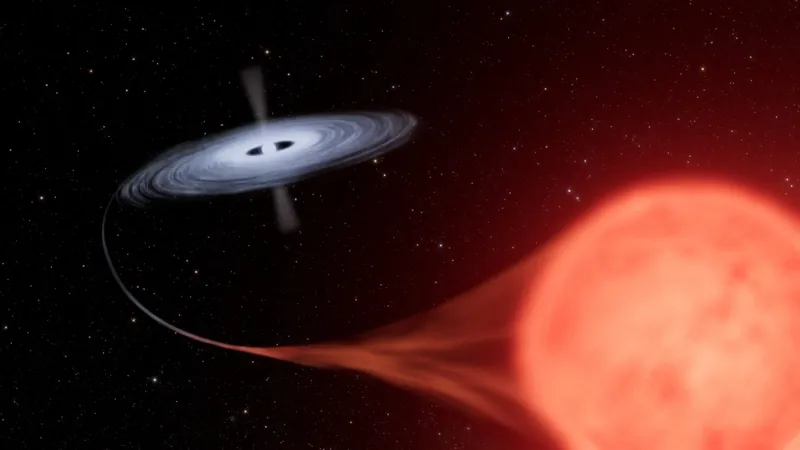
Headless 'Halloween Comet' Faces Potential Doom as Disintegration Looms
2024-10-23
Author: Daniel
Overview
The latest news about Comet C/2024 S1 (ATLAS), dubbed "the other comet" of October 2024, paints a grim picture. As it races toward a near brush with the sun, experts believe it could fully disintegrate before reaching its closest approach early next week.
Initial Excitement Turns to Disappointment
Previously, on October 10, reports indicated that this comet from the Kreutz family of sungrazing comets was breaking apart. Despite initial excitement about its potential visual spectacle, recent assessments suggest Comet ATLAS is unlikely to become the bright astronomical attraction some had hoped for, especially compared to its October counterpart, Comet Tsuchinshan-ATLAS.
Excitement peaked with a sensational tabloid article on October 21, which claimed that Comet ATLAS might evolve into an extraordinary "Halloween treat" bright enough to be seen during daylight. However, this has led to misunderstanding, as the comet’s actual trajectory indicates it’s more likely to fade into obscurity against the bright solar backdrop in the coming days.
Current Brightness
As of now, Comet ATLAS’s brightness stands at a faint magnitude of +10, roughly 40 times dimmer than the faintest stars visible to the naked eye. Some observers have even reported that the comet seems to be growing dimmer, not brighter, as it approaches the sun.
An Ancient Fragment Looms
Comet ATLAS is part of a long history of fragmentation, originating from a colossal comet that broke apart nearly a thousand years ago. These fragments have since been on a perilous trajectory close to the sun, making Comet ATLAS part of a recurrent cycle with an estimated orbital return of 500 to 800 years. The comet is forecasted to come within a mere 341,000 miles of the sun's surface on October 28, enduring immense temperatures and gravitational forces that could obliterate it entirely.
Observers will be able to follow the comet’s trajectory using real-time data from the LASCO C3 coronagraph aboard the Solar and Heliospheric Observatory (SOHO) when it passes the sun at around 8 a.m. EDT on October 28.
Initial Hopes Dashed
Discovered on September 27 in Hawaii, Comet ATLAS was initially mistaken for an asteroid before its cometary nature was confirmed. Expectations rose because some Kreutz comets have previously dazzled observers with brilliant displays and expansive tails. Historic comets like those in 1680, 1811, and 1965 left enduring impressions with their eye-catching phenomena.
Now, with Comet ATLAS in the spotlight, astronomer Qicheng Zhang from Arizona's Lowell Observatory has noted that the comet has likely disintegrated, with its core almost entirely lost. This brings to mind tales of headless comets, as the remnants may only present a faint tail rather than a fully formed comet nucleus.
The Search for a Spectacle
Despite the dim prospects, skywatchers may still attempt to spot a remnant of this so-called headless comet, particularly starting on Halloween morning. If visible, it may resemble a faint, glowing contrail in the east-southeast horizon shortly before sunrise—a ghostly reminder of a comet that might have vanished into the solar inferno.
However, it's essential for enthusiasts to temper expectations, as Comet ATLAS could very well be completely consumed during its close approach, leading to what many may perceive as a disappointing Halloween trick instead of the anticipated treat. Stay tuned for updates as we monitor this cosmic event!


 Brasil (PT)
Brasil (PT)
 Canada (EN)
Canada (EN)
 Chile (ES)
Chile (ES)
 Česko (CS)
Česko (CS)
 대한민국 (KO)
대한민국 (KO)
 España (ES)
España (ES)
 France (FR)
France (FR)
 Hong Kong (EN)
Hong Kong (EN)
 Italia (IT)
Italia (IT)
 日本 (JA)
日本 (JA)
 Magyarország (HU)
Magyarország (HU)
 Norge (NO)
Norge (NO)
 Polska (PL)
Polska (PL)
 Schweiz (DE)
Schweiz (DE)
 Singapore (EN)
Singapore (EN)
 Sverige (SV)
Sverige (SV)
 Suomi (FI)
Suomi (FI)
 Türkiye (TR)
Türkiye (TR)
 الإمارات العربية المتحدة (AR)
الإمارات العربية المتحدة (AR)